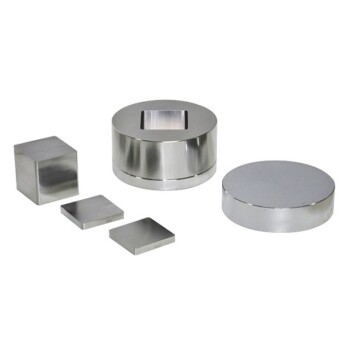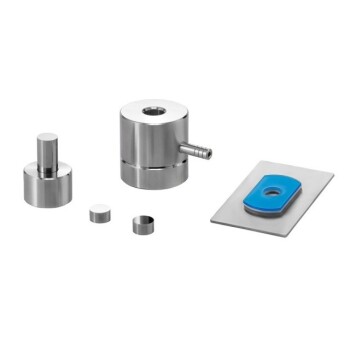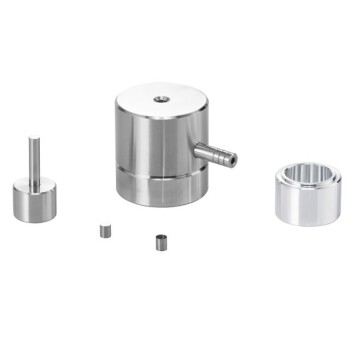For certain specific applications, alternatives to traditional lab presses do exist, primarily in the form of specialized accessories. These tools are designed to accomplish a single task, such as producing thin polymer films for spectroscopic analysis, without the need for a large, hydraulic press.
The core decision is not about replacing the lab press entirely, but understanding when a specialized, single-task tool is a sufficient and more efficient alternative. A lab press remains essential for high-pressure or multi-purpose applications.
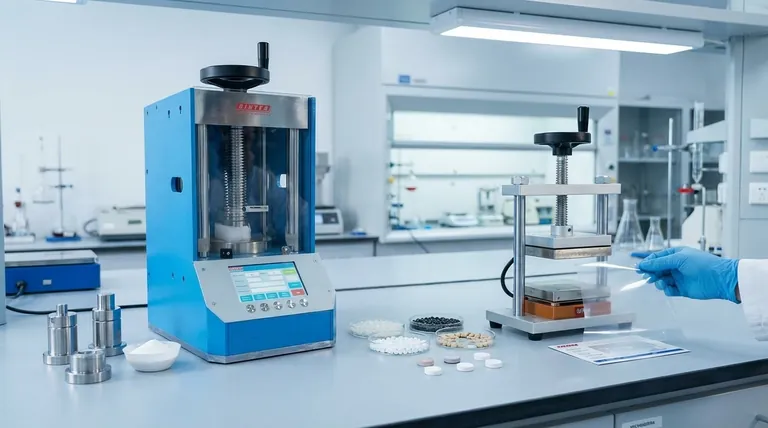
The Versatile Role of the Lab Press
A traditional laboratory press is a foundational piece of equipment designed to apply significant, controlled force to a sample. This capability is leveraged across several common laboratory preparation techniques.
Preparing KBr Pellets for IR Spectroscopy
For infrared (IR) spectroscopy, solid organic samples are often ground with potassium bromide (KBr) powder. A lab press is then used to apply immense pressure, fusing the mixture into a transparent pellet through which the IR beam can pass.
Briquetting Samples for XRF Spectroscopy
In X-ray fluorescence (XRF) spectroscopy, powdered or inorganic samples are frequently pressed into dense, solid pucks or briquettes. This creates a sample with a uniform, flat surface, which is critical for obtaining accurate and repeatable analytical results.
Creating Thin Polymer Films
Using heated platens, a lab press can melt and press polymer pellets or powders into thin, consistent films. These films are then ideal for analysis via IR transmission, allowing the chemical structure of the polymer to be identified.
Other General-Purpose Applications
Beyond spectroscopy, the general ability to apply controlled pressure and heat makes lab presses useful for tasks like materials testing, laminating, and creating dense pills or tablets from powdered substances.
The Targeted Alternative: Press-Free Film Makers
The primary alternative to a lab press is not another press, but a highly specialized, manual accessory. These devices are purpose-built for one of the applications mentioned above.
The Core Application: Thin Polymer Films
New accessories are now available that allow a technician to create a high-quality thin film from a polymer sample without a press. These devices typically use a manual screw mechanism to apply localized pressure between two heated plates.
How They Offer an Advantage
The value of these alternatives is their simplicity and specificity. They eliminate the need for a large, heavy, and often expensive piece of equipment for a single, routine task. This makes the process more accessible and can save significant bench space.
Understanding the Trade-offs
Choosing an alternative tool requires a clear understanding of what you gain and what you give up. The decision hinges entirely on the scope of your laboratory's needs.
When a Lab Press is Still Essential
A dedicated film-making accessory cannot replace a lab press. If you need to prepare KBr pellets or XRF briquettes, the high pressures required mean a hydraulic lab press is non-negotiable. Its versatility for different sample types and applications remains its key strength.
The Limitation of the Alternative
A press-free film maker is a single-task tool. It is designed only for creating thin polymer films and lacks the pressure range, platen size, and overall flexibility to perform other press-related tasks.
The Benefit of a Dedicated Tool
If your lab's only pressing application is the creation of polymer films for IR analysis, the dedicated accessory is a superior choice. It is often faster, easier to use, and has a much smaller footprint and lower cost than a full lab press.
Making the Right Choice for Your Goal
To select the correct equipment, you must first define the specific sample preparation task you need to accomplish.
- If your primary focus is creating thin polymer films for IR spectroscopy: A dedicated, press-free film-making accessory is a highly efficient and cost-effective solution.
- If your primary focus is preparing KBr pellets or XRF briquettes: A traditional hydraulic lab press is the required standard and there is no practical alternative.
- If your needs are varied and include films, pellets, and other materials: A versatile lab press, potentially with heated platens, is the most logical and necessary investment.
Ultimately, matching the tool precisely to your application ensures you have the right capability without investing in unnecessary complexity.
Summary Table:
| Application | Best Tool | Key Features |
|---|---|---|
| Thin Polymer Films for IR | Press-Free Film Maker | Manual screw mechanism, heated plates, compact design |
| KBr Pellets for IR | Lab Press | High-pressure capability, versatile for various samples |
| XRF Briquettes | Lab Press | Uniform pressure for accurate, repeatable results |
| General-Purpose Tasks | Lab Press | Controlled force and heat for testing and laminating |
Struggling to choose the right equipment for your lab? KINTEK specializes in lab press machines, including automatic lab presses, isostatic presses, and heated lab presses, designed to meet diverse laboratory needs like KBr pellet preparation, XRF briquetting, and polymer film creation. Our solutions ensure precision, efficiency, and reliability for your sample preparation tasks. Contact us today to discuss how we can enhance your lab's performance and find the perfect fit for your applications!
Visual Guide
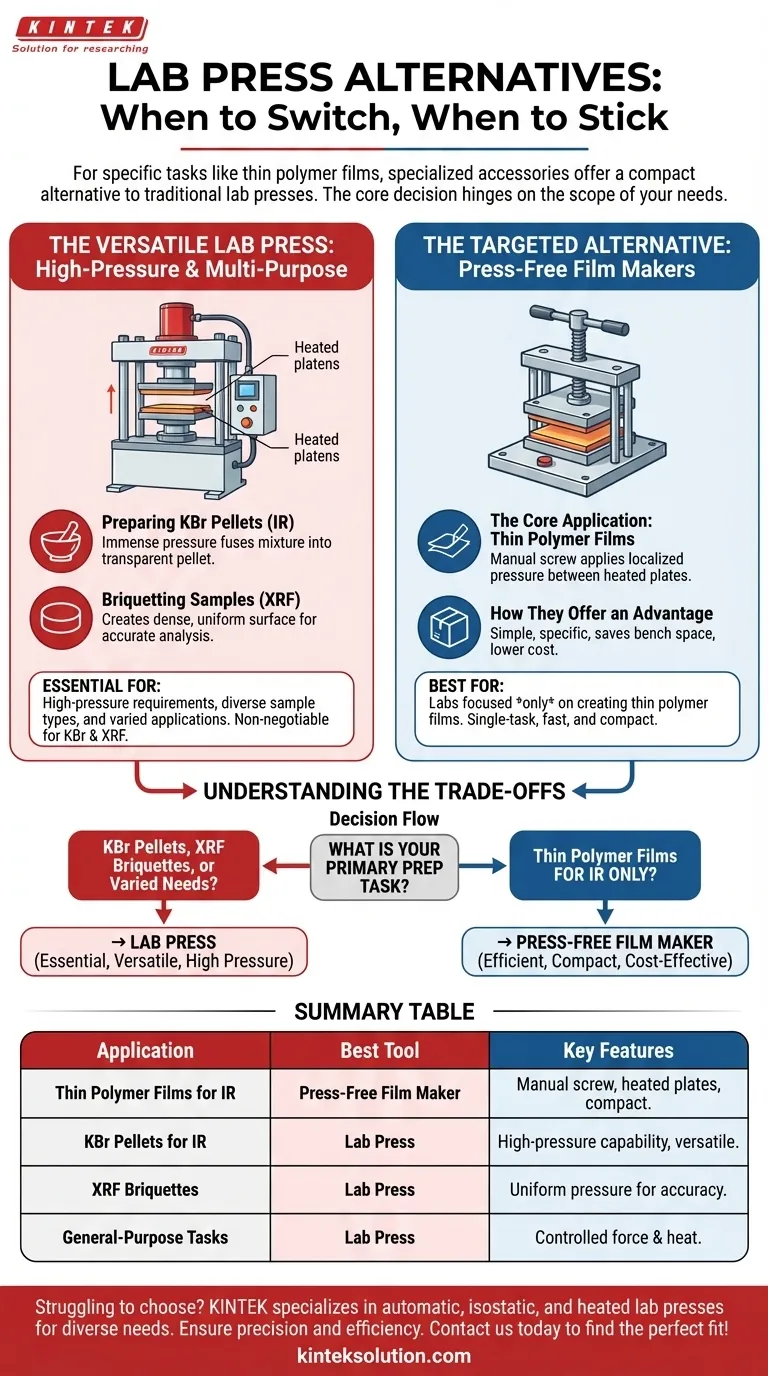
Related Products
- Automatic Laboratory Hydraulic Press Lab Pellet Press Machine
- Laboratory Hydraulic Split Electric Lab Pellet Press
- Automatic Laboratory Hydraulic Press for XRF and KBR Pellet Pressing
- Manual Laboratory Hydraulic Press Lab Pellet Press
- Laboratory Hydraulic Press Lab Pellet Press Machine for Glove Box
People Also Ask
- How does a hydraulic press aid in XRF spectroscopy? Achieve Accurate Elemental Analysis with Reliable Sample Prep
- What is the purpose of creating pellets for XRF spectroscopy using a hydraulic press? Ensure Accurate and Repeatable Elemental Analysis
- How do hydraulic pellet presses contribute to material testing and research? Unlock Precision in Sample Prep and Simulation
- How do hydraulic press machines ensure precision and consistency in pressure application? Achieve Reliable Force Control for Your Lab
- What are the key steps for making good KBr pellets? Master Precision for Flawless FTIR Analysis









